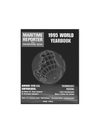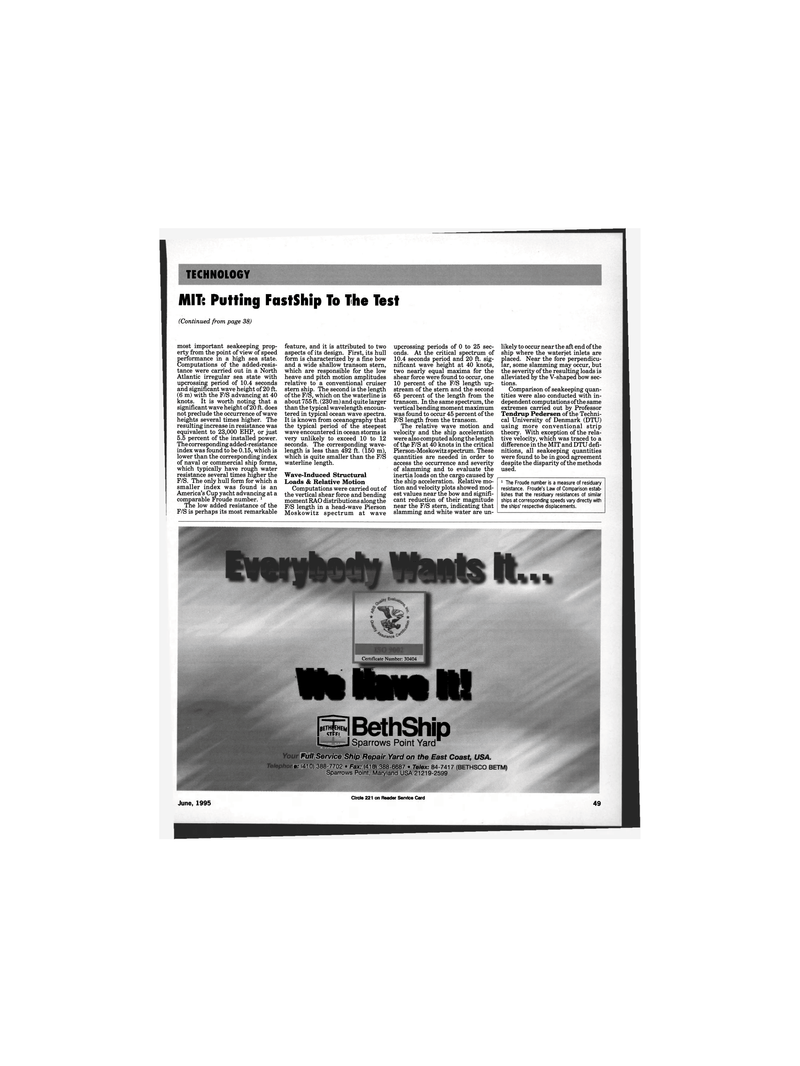
Page 47: of Maritime Reporter Magazine (June 1995)
Read this page in Pdf, Flash or Html5 edition of June 1995 Maritime Reporter Magazine
TECHNOLOGY
MIT: Putting FastShip To The Test (Continued, from page 38) most important seakeeping prop- erty from the point of view of speed performance in a high sea state.
Computations of the added-resis- tance were carried out in a North
Atlantic irregular sea state with upcrossing period of 10.4 seconds and significant wave height of 20 ft. (6 m) with the F/S advancing at 40 knots. It is worth noting that a significant wave height of 20 ft. does not preclude the occurrence of wave heights several times higher. The resulting increase in resistance was equivalent to 23,000 EHP, or just 5.5 percent of the installed power.
The corresponding added-resistance index was found to be 0.15, which is lower than the corresponding index of naval or commercial ship forms, which typically have rough water resistance several times higher the
F/S. The only hull form for which a smaller index was found is an
America's Cup yacht advancing at a comparable Froude number. 1
The low added resistance of the
F/S is perhaps its most remarkable feature, and it is attributed to two aspects of its design. First, its hull form is characterized by a fine bow and a wide shallow transom stern, which are responsible for the low heave and pitch motion amplitudes relative to a conventional cruiser stern ship. The second is the length of the F/S, which on the waterline is about 755 ft. (230 m) and quite larger than the typical wavelength encoun- tered in typical ocean wave spectra.
It is known from oceanography that the typical period of the steepest wave encountered in ocean storms is very unlikely to exceed 10 to 12 seconds. The corresponding wave- length is less than 492 ft. (150 m), which is quite smaller than the F/S waterline length.
Wave-Induced Structural
Loads & Relative Motion
Computations were carried out of the vertical shear force and bending moment RAO distributions along the
F/S length in a head-wave Pierson
Moskowitz spectrum at wave upcrossing periods of 0 to 25 sec- onds. At the critical spectrum of 10.4 seconds period and 20 ft. sig- nificant wave height at 40 knots, two nearly equal maxima for the shear force were found to occur, one 10 percent of the F/S length up- stream of the stern and the second 65 percent of the length from the transom. In the same spectrum, the vertical bending moment maximum was found to occur 45 percent of the
F/S length from the transom.
The relative wave motion and velocity and the ship acceleration were also computed along the length of tbje F/S at 40 knots in the critical
Pierson-Moskowitz spectrum. These quantities are needed in order to access the occurrence and severity of slamming and to evaluate the inertia loads on the cargo caused by the ship acceleration. Relative mo- tion and velocity plots showed mod- est values near the bow and signifi- cant reduction of their magnitude near the F/S stern, indicating that slamming and white water are un- likely to occur near the aft end of the ship where the waterjet inlets are placed. Near the fore perpendicu- lar, some slamming may occur, but the severity of the resulting loads is alleviated by the V-shaped bow sec- tions.
Comparison of seakeeping quan- tities were also conducted with in- dependent computations of the same extremes carried out by Professor
Tendrup Pedersen of the Techni- cal University of Denmark (DTU) using more conventional strip theory. With exception of the rela- tive velocity, which was traced to a difference in the MIT and DTU defi- nitions, all seakeeping quantities were found to be in good agreement despite the disparity of the methods used. 1 The Froude number is a measure of residuary resistance. Froude's Law of Comparison estab- lishes that the residuary resistances of similar ships at corresponding speeds vary directly with the ships' respective displacements.
Certificate Number: 30404
VfeNsvtlt!
FSBethShip
I J Sparrows Point Yard
Full Service Ship Repair Yard on the East Coast, USA. e: (410) 388-7702 • Fax: (410) 388-6687 • Telex: 84-7417 (BETHSCO BETM)
Sparrows Point, Maryland USA 21219-2599
June, 1995
Circle 221 on Reader Service Card 49

 46
46

 48
48
